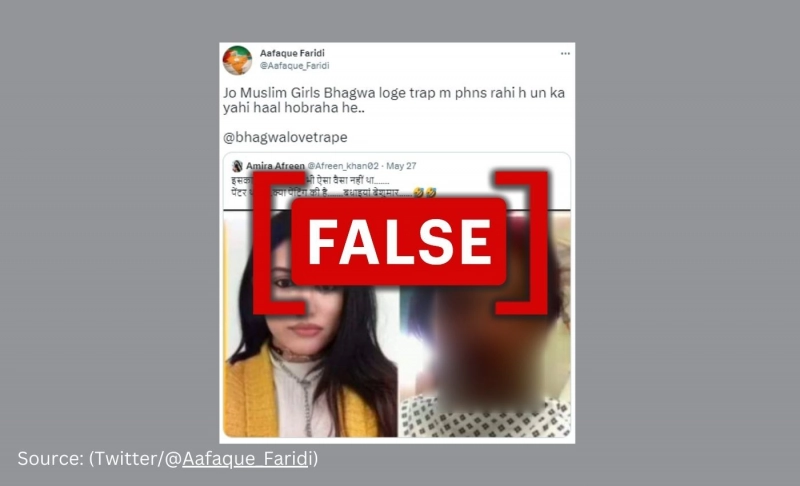By: Annet Preethi Furtado
May 30 2023

The images being shared are from 2017 when a man named John Tomlin threw acid on a 21-year-old girl. The two had no prior connection whatsoever.
Context
In May 2023, multiple social media posts with two images of an acid assault victim attributed the attack to a Hindu man and portrayed the images as a "before and after" comparison of the victim's appearance. The comparative image displayed a girl wearing white and yellow attire on the left, while the other image portrayed the girl with severe facial burns. Posts suggested that such incidents target Muslim girls supposedly trapped in a "Bhagwa love trap”.
Some of the posts included captions in Hindi which translate to ''Her Ram Lal is not like this. Even if Ram Lal loved you, you have ruined your religion and afterlife," and a hashtag #भगवा_लव_ट्रैप (Bhagwa love trap). The term "bhagwa love trap" refers to a phrase used on social media, particularly in the context of communal posts, to describe a perceived strategy or conspiracy involving Hindu men entangling or trapping Muslim women in romantic relationships. The term implies a conspiracy that Hindu men are pursuing such relationships to eventually convert these women to Hinduism, thus playing on communal tensions.
In Fact
Upon conducting a reverse image search, we verified that the two images shared on social media depict Resham Khan, who, along with her cousin, was attacked on her birthday on June 21. The incident occurred in June 2017 when Khan and Jameel Muhktar were in their vehicle, stopped at a traffic light in Beckton, East London. In 2017, police reclassified the attack as a hate crime when new evidence came to light.
The attack was perpetrated by John Tomlin, as captured in a CCTV clip where Tomlin can be seen rushing towards a car to throw acid through the window, targeting the two. In 2018, he pleaded guilty and was sentenced at Snaresbrook Crown Court to 16 years imprisonment. According to a report by The Guardian, the court proceedings revealed that Tomlin had been diagnosed with emotional instability and a personality disorder. Additionally, it was reported that he had a history of previous convictions, which included violent offenses, burglaries, and theft.
This was an unprovoked attack, and the victims had no prior association or familiarity with the attacker. The judge presiding over the case, Sheelagh Canavan, characterized the assault as "somewhat random," indicating that it occurred without a discernible motive. The claim that the attack was due to Khan being trapped in a "Bhagwa love trap" is entirely unfounded. Khan and the other victim had no prior relationship or knowledge of the offender.
Moreover, the religious affiliation of the acid attack perpetrator, Tomlin, remains undisclosed. There is also no confirmed involvement of a Hindu man in the acid attack on Resham, as is insinuated in the social media posts.
Following her recovery from the acid attack in October 2017, Khan posted a picture of herself wearing yellow and white attire on social media, accompanied by the caption, "Time to stop hiding." This photograph has been inaccurately shown as a pre-attack image in the viral posts.
The Verdict
In 2017, Resham Khan and Jameel Muhktar were subjected to an acid attack by a man called John Tomlin in London. This incident from 2017 had no connection to India, and the attack was neither carried out by a man Khan was in a relationship with, nor by someone publicly known to be a Hindu. The photographs of Khan have been shared with a false communal narrative.